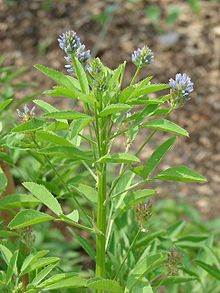Trigonella caerulea
| Blue fenugreek | |
|---|---|

| |
| Scientific classification | |
| Kingdom: | Plantae |
| Clade: | Tracheophytes |
| Clade: | Angiosperms |
| Clade: | Eudicots |
| Clade: | Rosids |
| Order: | Fabales |
| Family: | Fabaceae |
| Subfamily: | Faboideae |
| Genus: | Trigonella |
| Species: | T. caerulea
|
| Binomial name | |
| Trigonella caerulea | |
MHNT
Trigonella caerulea (blue fenugreek,
Use
Blue fenugreek is widely used in Georgian cuisine, where it is known as utskho suneli.[4] It is one of the ingredients of the Georgian spice mix khmeli suneli.[6] The seeds, the pods and the leaves are used. The smell and taste are similar to ordinary fenugreek, but milder.[7] In Switzerland it is used for flavouring the traditional schabziger cheese.[8]
References
- ^ "Trigonella caerulea". Germplasm Resources Information Network. Agricultural Research Service, United States Department of Agriculture. Retrieved 2013-07-29.
- ^ USDA, NRCS (n.d.). "Trigonella caerulea". The PLANTS Database (plants.usda.gov). Greensboro, North Carolina: National Plant Data Team. Retrieved 15 December 2015.
- ^ "Trigonella caerulea (L.) Ser. "Blue Fenugreek"". Botanical Society of Britain and Ireland. Retrieved 2019-12-15.
- ^ a b Rodov V.; Vinokur Y.; Gogia N.; Chkhikvishvili I.D. (2010). "Hydrophilic and lipophilic antioxidant capacities of Georgian spices for meat and their possible health implication" (PDF). Georgian Medical News. 179 (2): 61–66.)
- ^ AgroAtlas, accessed 29 July 2013.
- ISBN 0-520-21929-5.
- ^ Blue fenugreek, Gernot Katzer's spice dictionary
- ^ Kräuter und Gewürze aus heimischem Anbau (in German)
External links
 The dictionary definition of blue fenugreek at Wiktionary
The dictionary definition of blue fenugreek at Wiktionary
